Children: the Real Victims Of Climate Change
One Billion Children And Adolescents Around the World Are At Risk Of Suffering the Worst Effects Of Climate Change.

Climate change continues to leave devastating long-term forecasts, as according to UNICEF, its impacts could put almost all the world’s children at risk. Photo: Pixabay
LatinAmerican Post | Brandon Martínez Salazar
Listen to this article
Leer en español: Los niños y las niñas: las principales víctimas del cambio climático
According to UNICEF, the consequences of climate change could put almost all the world's children at risk. According to the most recent studies, 2020 was the hottest year on record, with the highest levels of carbon dioxide in the atmosphere in 3.5 million years. This is worrying because it shows the little interest of industrialized countries in mitigating the environmental pollution caused by the mercantile system.
Obviously, this has started to wreak havoc in different parts of the planet, causing droughts, heavy flooding, air pollution, and water scarcity, which represents a risk for children who are faced with poor nutrition and exposed to serious diseases.
Children and young people are more affected by air pollution than adults because they breathe faster and take in more pollutants.
A breath of fresh air needs urgent climate action. pic.twitter.com/SqZeaOveNN
— UNICEF (@UNICEF) August 25, 2021
UNICEF warns that this problem of climate change affects almost all the aspects of younger people's lives such as their health, food, education and their own survival. So current and future generations will be forced to live in precariousness due to the lack of attention from governments in these situations, which already leave a discouraging message.
On the other hand, water, an essential liquid for human existence, is increasingly affected by the alteration of meteorological phenomena, which in itself exacerbates its scarcity, affecting the supply of vulnerable populations. In addition, the contamination of water resources hinders access to drinking water, generating critical health problems in infants.
Also read: Environment: What can we learn from Generation Z?
Latin america and the caribbean
According to UNICEF's first Child Climate Risk Index, one billion children around the world are at extremely high risk of suffering the consequences of climate change. In Latin America and the Caribbean it is presumed that 9 out of 10 children would be exposed to this situation.
The report is worrying because the figures show that:
- 55 million children are exposed to water scarcity;
- 60 million children are exposed to cyclones;
- 85 million children are exposed to Zika;
- 115 million children are exposed to Dengue;
- 45 million children are exposed to heat waves;
- 105 million children are exposed to air pollution.
The curious thing about the causes of climate change is that the 33 countries that are classified as high risk only emit 9% of the CO2 emissions on the planet, while the 10 countries that most pollute the environment are those that produce 70% of greenhouse gases and only one of them is at high risk. In short, the underdeveloped nations would be paying for the actions of the industrialized nations.
“Climate change is deeply uneven. Although no child is responsible for the rise in global temperatures, they will suffer the worst consequences. Children in the least responsible countries will suffer more than anyone, ”said Henrietta Fore, UNICEF Executive Director.
Africa and Asia
- In Kabul, the child population is at great risk of suffering from respiratory diseases such as pneumonia from the burning of fossils, and other solid waste.
- In Dhaka (Bangladesh), due to the poor air quality, increases in diseases such as asthma, allergies, heart disease, and lung cancer have been reported.
- In the past ten years, Cambodia has recorded nearly a million victims of heavy flooding.
- 2020 was a chaotic year for the Democratic Republic of the Congo as the overflowing of the Mutahyo River caused 80% of the Masisi fields to be totally destroyed and, therefore, the existence of livestock and food was lost.
- In January this year, Cyclone Eloise in Mozambique destroyed crops, roads and thousands of families were left homeless, after experiencing another cyclone two years ago. The affected people had to travel to other places to seek help.
UNICEF asks, among other points, to reduce greenhouse gas emissions to avoid worse effects in the coming years. It suggests that it is important to take strong action before 2030 and that countries must reduce air pollution by at least 45% to prevent the temperature from rising 1.5 degrees.
It also proposes educating children about the climate and ecological competencies for their adaptation and preparation for the environmental challenges to which they will be exposed in the following decades. Likewise, it warns that it is essential to include young people in negotiations and decisions that are related to the climate at the national, regional and international levels.




